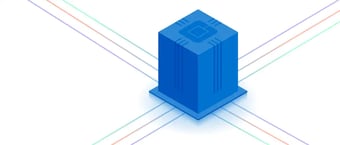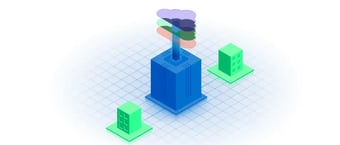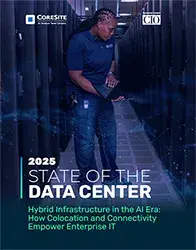
Making Hybrid IT Work: Why Interconnection Belongs on Your Priority List
Interconnection makes hybrid IT work. It provides integration and connectivity for applications and services on-premises, in colocation data centers and public clouds. In this post, I explain the basics of interconnection and highlight findings in the 2025 State of the Data Center report. Why focus on interconnection, you ask? It was one of the top priorities for 300+ IT decision makers surveyed for the report.
What Is Interconnection?
The big picture of interconnection (or hybrid connectivity) is that it enables access to resources across a hybrid IT environment. Think of a highway as an analogy for interconnection. Instead of vehicles, data traffic flows across and between facilities, at high speeds and without jams.
Depending on proximity and requirements, interconnection uses physical or virtual connectivity. The physical connections are cables called cross connects. They provide private, point-to-point data exchange between two companies in the same data center. Entities with a presence in the facility – enterprises, cloud service providers, AI startups, network service providers, systems integrators and so on – use cross connects to exchange data reliably, at low latency and with high security.
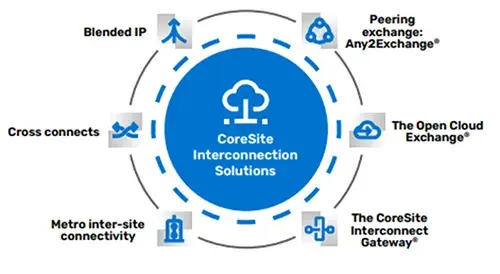
Virtual connectivity is used when companies want to exchange data between endpoints that are not in the same facility. Keep in mind that virtual connections can be made between entities in the same facility, if desired. Using private, software-defined connections, you can connect to multiple clouds or service providers and quickly turn up or down connections as well as workload usage. The Open Cloud Exchange® (OCX) is CoreSite’s software-defined networking platform that simplifies site-to-site and hybrid cloud interconnection and management. If you’re looking for an interconnection “easy button,” the OCX is it.
I also want to mention there are several methods of interconnection. This isn’t a one-size-fits-all solution. The best starting point, if you’re new to interconnection, is to talk to us about your situation, so we can recommend an interconnection solution specific to your business and IT goals. All questions are good questions when it comes to making the most of hybrid IT.
Hybrid IT, Interconnection and Digital Ecosystems
According to the 2025 State of the Data Center report, 98% of IT leaders have adopted or plan to adopt a hybrid IT model. This makes sense. Hybrid IT makes it easier to manage applications and workloads on premises, in colocation and in public or private clouds. After years of experience with hybrid IT, I’ve seen how interconnection truly does enable digital transformation, business growth and cost savings.
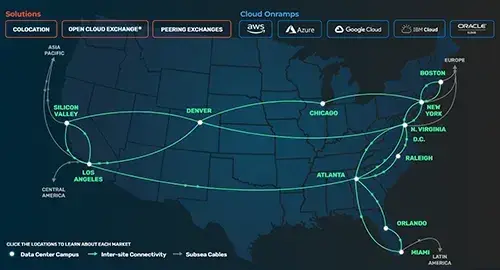
I’m still excited about interconnection – especially to see it perform so well as the backbone of digital ecosystems. Your company can interoperate with customers, suppliers and partners in multiple data centers in multiple regions. I doubt it’s possible for companies to transform and innovate without an ecosystem. Collaboration has many advantages when you have the right connectivity and ecosystem partners. Businesses can adopt new technology faster and less expensively compared to traditional tech refreshes. Automation and orchestration boost efficiency. And an ecosystem makes it easier to expand operations geographically and vertically. Also, you’ll be able to analyze data to improve operations, products and services.
I’ll use a CoreSite map to help you visualize interconnection and ecosystems. The named cities are locations where we have data centers and campuses. The green interconnection “highways” enable inter-site connectivity among enterprise colocation deployments and with ecosystem partners. The gray subsea cables expand digital ecosystems access to Asia Pacific, Europe and Latin America. Direct cloud connections to AWS, Azure, Google Cloud, IBM Cloud and Oracle Cloud are available in different cities.
A digital ecosystem is a network of interactive interconnected tools, platforms, collaborating companies, people and services. The collaborating businesses have a presence in one or more colocation data centers.
Interconnection Is a “Must Have”
The 2025 State of the Data Center report notes that most respondents consider direct connectivity through a colocation provider a “must have.” Yet, the number of colocation data centers that offer interconnection services has decreased for the second consecutive year. Only 19% offer interconnection to multiple cloud providers – a drop of nearly half since 2023. Why the drop? I think it has something to do with the increase in colocation providers’ focus on hyperscale solutions (as well as the overall growth in the development of hyperscale), which typically don’t offer interconnection.
What’s behind the “must have”? Based on my experience in client services and operational support, I think interconnection is viewed so positively because it checks a lot of boxes.
- Rapid data transmission improves the response times of applications and services.
- Flexible workload placement between clouds, on-premises or colocation. More AI workloads are transitioning to colocation data centers to take advantage of high-compute density and scalability.
- Cost advantages result from making the best use of infrastructure while reducing data egress costs compared to transferring data over the public internet.
- Private interconnection increases data protection and supports compliance.
- Companies that are interconnected in different regions can rely on distant facilities for business continuity and disaster recovery. They can distribute workloads to several locations if necessary.
- Companies can innovate and grow when they are able to scale quickly, distribute applications and expand into new regions.
IT Decision-Makers Rank Desired Colocation Capabilities
Colocation is steadily increasing its role in hybrid IT. In addition to interconnection, IT leaders consider many other factors in choosing a colo provider. Those surveyed for the 2025 State of the Data Center report weighed in again this year. Security (physical and cyber) remains in the No. 1 spot. Support and service quality is now No. 2. You can see in the chart how other attributes have moved up or down.
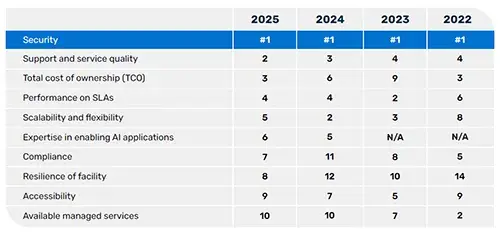
“The attributes [we look for] in a colo provider are points of presence … can they connect to the different cloud providers that we operate with? Do they have the breadth of services to support AI workloads or multicloud.”
Senior Retail IT Director (2025 State of the Data Center report by Foundry and CoreSite)
Interconnection Services Make Hybrid IT Work
As IT organizations continue to shift toward hybrid environments, they’ll rely even more on colocation providers. Only colocation providers with interconnection services can help enterprises make the most of hybrid IT. And not all interconnection services are equal. Also, many if not most colocation data centers have ecosystems, but ecosystems vary in terms of participating companies and the range of services. Check out our digital marketplace.
Last, but not least, when you evaluate colocation providers, please think about two things. What can you connect, and how easy is it to connect and collaborate? We would welcome the opportunity to discuss how CoreSite addresses those questions.
Know More
Now in its sixth year, the 2025 State of the Data Center research, conducted by Foundry, surveyed 300+ CIOs, CTOs and other IT decision-makers representing a variety of industry sectors. In addition to the online survey, Foundry conducted in-depth interviews with seven senior technology executives from enterprise organizations in the financial services, healthcare, retail and software-as-a-service (SaaS) sectors.
Download the 2025 State of the Data Center report


